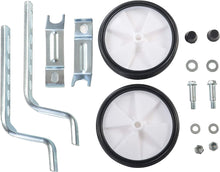Top Road Power Training Wheels are specifically designed to help children learn to ride their bikes independently and confidently. These training wheels come in size ranges of 12-20 inches, which are suitable for a wide range of bike models, making it a versatile investment for parents. Here are some of the top features of the Top Road Power Training Wheels:
• A sturdy build: The training wheels’ durable steel construction makes them sturdy enough to handle the wear and tear of little ones learning to ride.
• Easy to install: The wheels come with all necessary hardware and tools for quick and easy installation onto the bike.
• Adjustable height: The height of the training wheels can be adjusted, meaning that as the child becomes more confident, the training wheels can gradually be raised, allowing them to ride without support.
• Smooth and stable ride: The wheels’ rubber tires offer a smooth and stable ride, further building the child’s confidence as they learn to balance on their bike.
• Bright color options: The training wheels offer fun and vibrant color options for kids to choose from, adding an element of personal style to their bike.
• Compatible with most bikes: As mentioned, the Top Road Power Training Wheels come in a broad range of sizes, making them compatible with most bike models on the market.
Overall, Top Road Power Training Wheels are an excellent investment for parents who are looking to help their child learn how to ride a bike. They offer a strong build, easy setup, and plenty of versatility, ensuring that children of all ages and skill levels can benefit from them.


Bicycle Training Wheels: How to Use Them to Teach Your Kids to Ride Without Them
Learning to ride a bicycle is a rite of passage for many children, and bicycle training wheels can be an invaluable tool in helping kids gain the confidence and balance necessary to ride on two wheels. In this article, we will discuss how to use training wheels effectively to help your child learn to ride a bike and offer some tips on when to consider using heavy-duty adult training wheels and specialized training wheels for special needs individuals.

When to Use Training Wheels
The age and weight at which a child is ready to use training wheels will vary depending on the child's physical development and coordination. Generally, children between the ages of three and six years old are good candidates for training wheels. As for weight, training wheels can typically accommodate children up to 75 pounds.

When choosing a bike, make sure it's the right size for your child. A bike that's too big or too small can make it more difficult to learn to ride. When your child sits on the bike, they should be able to touch the ground with both feet flat on the ground. The handlebars should be within easy reach, and the child should be able to reach the brakes comfortably.

How to Use Training Wheels
Before you attach the training wheels to the bike, make sure the bike is in good condition. Check the brakes, tires, and chain to ensure that everything is working properly. Next, attach the training wheels to the rear axle of the bike. Adjust the height of the training wheels so that they are just off the ground. You want them to provide stability to the bike, but you don't want the bike to lean too much to one side or the other.
Once the training wheels are attached, have your child sit on the bike and practice pedaling. Encourage them to steer and practice turning. As they become more comfortable, gradually raise the training wheels off the ground by a few millimeters. Continue to do this until the wheels are no longer touching the ground. The goal is to help your child gain the balance and coordination necessary to ride without training wheels.

Heavy Duty Adult Training Wheels
If you're an adult who is learning to ride a bike for the first time, or you're someone who needs extra support due to a physical disability or condition, heavy-duty adult training wheels can be a helpful tool. Heavy-duty training wheels are designed to support more weight and provide more stability than standard training wheels.

When to Consider Specialized Training Wheels
For individuals with special needs or disabilities, specialized training wheels can offer additional support and stability. For example, children with Down syndrome or other conditions that affect balance and coordination may benefit from training wheels that are wider and provide more stability. Other specialized training wheels may be designed for individuals who have limited mobility or use a wheelchair.

Conclusion
Bicycle training wheels can be an effective tool in helping children learn to ride a bike. When choosing a bike, make sure it's the right size for your child, and attach the training wheels so that they provide stability without leaning the bike too much to one side or the other. As your child becomes more comfortable, gradually raise the training wheels until they are no longer touching the ground. Heavy-duty adult training wheels and specialized training wheels can also offer additional support and stability for individuals with special needs or disabilities.






